- Blog Categories
- Project Management
- Agile Management
- IT Service Management
- Cloud Computing
- Business Management
- Business Intelligence
- Quality Engineer
- Cyber Security
- Career
- Big Data
- Programming
- Most Popular Blogs
- PMP Exam Schedule for 2024: Check PMP Exam Date
- Top 60+ PMP Exam Questions and Answers for 2024
- PMP Cheat Sheet and PMP Formulas To Use in 2024
- What is PMP Process? A Complete List of 49 Processes of PMP
- Top 15+ Project Management Case Studies with Examples 2024
- Top Picks by Authors
- Top 170 Project Management Research Topics
- What is Effective Communication: Definition
- How to Create a Project Plan in Excel in 2024?
- PMP Certification Exam Eligibility in 2024 [A Complete Checklist]
- PMP Certification Fees - All Aspects of PMP Certification Fee
- Most Popular Blogs
- CSM vs PSM: Which Certification to Choose in 2024?
- How Much Does Scrum Master Certification Cost in 2024?
- CSPO vs PSPO Certification: What to Choose in 2024?
- 8 Best Scrum Master Certifications to Pursue in 2024
- Safe Agilist Exam: A Complete Study Guide 2024
- Top Picks by Authors
- SAFe vs Agile: Difference Between Scaled Agile and Agile
- Top 21 Scrum Best Practices for Efficient Agile Workflow
- 30 User Story Examples and Templates to Use in 2024
- State of Agile: Things You Need to Know
- Top 24 Career Benefits of a Certifed Scrum Master
- Most Popular Blogs
- ITIL Certification Cost in 2024 [Exam Fee & Other Expenses]
- Top 17 Required Skills for System Administrator in 2024
- How Effective Is Itil Certification for a Job Switch?
- IT Service Management (ITSM) Role and Responsibilities
- Top 25 Service Based Companies in India in 2024
- Top Picks by Authors
- What is Escalation Matrix & How Does It Work? [Types, Process]
- ITIL Service Operation: Phases, Functions, Best Practices
- 10 Best Facility Management Software in 2024
- What is Service Request Management in ITIL? Example, Steps, Tips
- An Introduction To ITIL® Exam
- Most Popular Blogs
- A Complete AWS Cheat Sheet: Important Topics Covered
- Top AWS Solution Architect Projects in 2024
- 15 Best Azure Certifications 2024: Which one to Choose?
- Top 22 Cloud Computing Project Ideas in 2024 [Source Code]
- How to Become an Azure Data Engineer? 2024 Roadmap
- Top Picks by Authors
- Top 40 IoT Project Ideas and Topics in 2024 [Source Code]
- The Future of AWS: Top Trends & Predictions in 2024
- AWS Solutions Architect vs AWS Developer [Key Differences]
- Top 20 Azure Data Engineering Projects in 2024 [Source Code]
- 25 Best Cloud Computing Tools in 2024
- Most Popular Blogs
- Company Analysis Report: Examples, Templates, Components
- 400 Trending Business Management Research Topics
- Business Analysis Body of Knowledge (BABOK): Guide
- ECBA Certification: Is it Worth it?
- How to Become Business Analyst in 2024? Step-by-Step
- Top Picks by Authors
- Top 20 Business Analytics Project in 2024 [With Source Code]
- ECBA Certification Cost Across Countries
- Top 9 Free Business Requirements Document (BRD) Templates
- Business Analyst Job Description in 2024 [Key Responsibility]
- Business Analysis Framework: Elements, Process, Techniques
- Most Popular Blogs
- Best Career options after BA [2024]
- Top Career Options after BCom to Know in 2024
- Top 10 Power Bi Books of 2024 [Beginners to Experienced]
- Power BI Skills in Demand: How to Stand Out in the Job Market
- Top 15 Power BI Project Ideas
- Top Picks by Authors
- 10 Limitations of Power BI: You Must Know in 2024
- Top 45 Career Options After BBA in 2024 [With Salary]
- Top Power BI Dashboard Templates of 2024
- What is Power BI Used For - Practical Applications Of Power BI
- SSRS Vs Power BI - What are the Key Differences?
- Most Popular Blogs
- Data Collection Plan For Six Sigma: How to Create One?
- Quality Engineer Resume for 2024 [Examples + Tips]
- 20 Best Quality Management Certifications That Pay Well in 2024
- Six Sigma in Operations Management [A Brief Introduction]
- Top Picks by Authors
- Six Sigma Green Belt vs PMP: What's the Difference
- Quality Management: Definition, Importance, Components
- Adding Green Belt Certifications to Your Resume
- Six Sigma Green Belt in Healthcare: Concepts, Benefits and Examples
- Most Popular Blogs
- Latest CISSP Exam Dumps of 2024 [Free CISSP Dumps]
- CISSP vs Security+ Certifications: Which is Best in 2024?
- Best CISSP Study Guides for 2024 + CISSP Study Plan
- How to Become an Ethical Hacker in 2024?
- Top Picks by Authors
- CISSP vs Master's Degree: Which One to Choose in 2024?
- CISSP Endorsement Process: Requirements & Example
- OSCP vs CISSP | Top Cybersecurity Certifications
- How to Pass the CISSP Exam on Your 1st Attempt in 2024?
- Most Popular Blogs
- Best Career options after BA [2024]
- Top Picks by Authors
- Top Career Options & Courses After 12th Commerce in 2024
- Recommended Blogs
- 30 Best Answers for Your 'Reason for Job Change' in 2024
- Recommended Blogs
- Time Management Skills: How it Affects your Career
- Most Popular Blogs
- Top 28 Big Data Companies to Know in 2024
- Top Picks by Authors
- Top Big Data Tools You Need to Know in 2024
- Most Popular Blogs
- Web Development Using PHP And MySQL
- Top Picks by Authors
- Top 30 Software Engineering Projects in 2024 [Source Code]
- More
- Tutorials
- Practise Tests
- Interview Questions
- Free Courses
- Agile & PMP Practice Tests
- Agile Testing
- Agile Scrum Practice Exam
- CAPM Practice Test
- PRINCE2 Foundation Exam
- PMP Practice Exam
- Cloud Related Practice Test
- Azure Infrastructure Solutions
- AWS Solutions Architect
- AWS Developer Associate
- IT Related Pratice Test
- ITIL Practice Test
- Devops Practice Test
- TOGAF® Practice Test
- Other Practice Test
- Oracle Primavera P6 V8
- MS Project Practice Test
- Project Management & Agile
- Project Management Interview Questions
- Release Train Engineer Interview Questions
- Agile Coach Interview Questions
- Scrum Interview Questions
- IT Project Manager Interview Questions
- Cloud & Data
- Azure Databricks Interview Questions
- AWS architect Interview Questions
- Cloud Computing Interview Questions
- AWS Interview Questions
- Kubernetes Interview Questions
- Web Development
- CSS3 Free Course with Certificates
- Basics of Spring Core and MVC
- Javascript Free Course with Certificate
- React Free Course with Certificate
- Node JS Free Certification Course
- Data Science
- Python Machine Learning Course
- Python for Data Science Free Course
- NLP Free Course with Certificate
- Data Analysis Using SQL
10 deadly myths of Agile and Scrum
By Lindy Quick
Updated on Jan 05, 2018 | 8 min read | 9.8k views
Share:
Agile and Scrum have been conquering the minds of engineers, managers especially from software industry, quite effectively since last few years. The impact is so much so that every software engineer thinks that if he/she is not working on an Agile or Scrum project, their career is stuck. It surely is, but so is the reality of this fact. Agile and Scrum have become so pervasive in our thought process that we, as engineers or managers or product owners do not stop to ask ourselves once if we really need any Agile methodologies to complete the project at hand or not. We simply assume that we are going to follow Agile and Scrum.
These bad practices or even myths [as we can safely call them due to lack of a better word] have crept in due to our insufficient understanding of the manifesto or Scrum alliance guidelines owing to the rush of getting onto the Agile train before it leaves us high and dry. And the impact of this short sightedness is the fact that we are adhering to mistakes in project execution techniques based on some popular concepts, because no one knows they are myths and have no resemblance to truth.
10 Deadly Myths of Agile and Scrum
Myth 1: Anybody Can Become a Scrum Master
Reality: A Scrum Master is supposed to be the person who does not involve personally into the discussions going on in the sprints and daily stand-ups and keeps his eyes on the goal even when emotions are running high during the Scrum meeting. So yes, anybody can become a Scrum Master playing many roles as long as they have emotional intelligence to deal with the varied opinions, discussions, and tendencies to derail the team away from the goal.
Hence, in reality, emotional intelligence is the most important prerequisite to become a Scrum Master.
Insider Tips to Land Your Dream Scrum Master Job
Includes Scrum Resume Sample
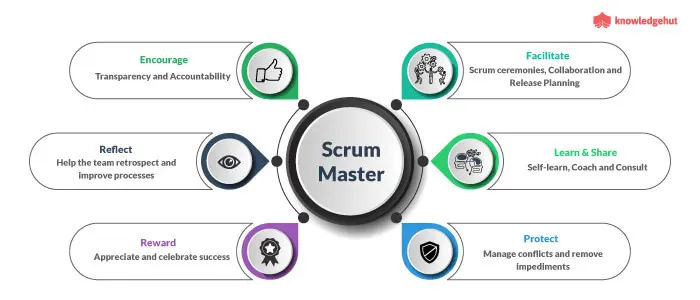
Myth 2: More Meetings Mean Scrum is Going Well
Reality: Scrum was supposed to be meeting-free except for the five known time boxed events [kick off, planning, scrum status, review, and post-mortem]. Apart from this, there are no more meetings required. And if your schedule is filled with multitude of so-called short meetings, then it is a clear sign that something is not right in the way Scrum is being done in your team.
Hence, the reality becomes, more meetings mean your Scrum is going ‘into’ the ‘well.’
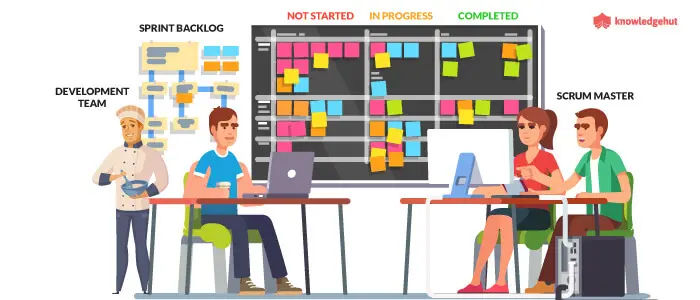
Myth 3: Daily Scrum Meeting is Same as the Status Meeting
Reality: Nothing could be further from the truth and intention if we think that daily scrum meeting is same as that of status meeting. It is not!
You must have seen multiple instances where team members give updates on what we did yesterday and what we plan to do today; they discuss issues and leave, assuming that today’s scrum was successful. In reality, that is a failure.
Scrum meeting is supposed to get together and quickly review the overall progress of the project based on efforts till last night against the end goal of project and quickly gauge if we are on track or not. That is followed by status meeting, where today’s tasks are quickly distributed along with the status check of in-flight items.
That’s how it should be.
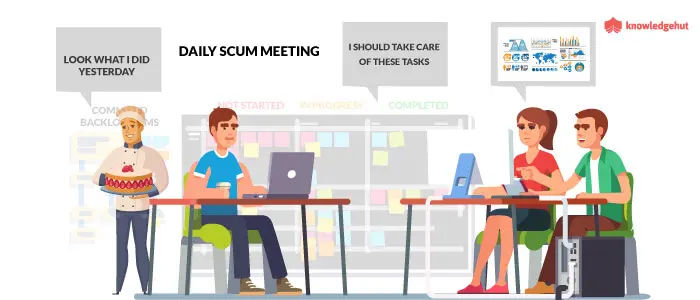
Myth 4: Velocity and Value are the Same Thing
Reality: This is so wrong on many fronts. This assumption implies that if a work is being done quickly, then it is taking us towards the end goal. Is that true?
Say a team member is creating automation with high velocity. But is it taking you closer towards shipping the product by the end date? No right?
Similarly, during Scrum meetings, we focus on the Value of work being done. It is possible that 100% of yesterday’s efforts might have contributed to 10% of total value. That is fine, as long as your idea of velocity and value is clear. Velocity is checked during status meeting, just to be clear. Velocity leads us to Value.
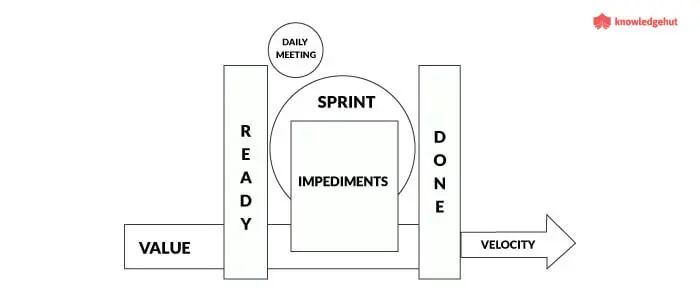
Myth 5: Only a Technical Person Can Become a Scrum Master
Reality: I want to correct that statement by saying a technical person can be made a Scrum master as long as they can ensure that they do not let their technical impulses interfere with their duties of being a Scrum Master.
If that cannot be guaranteed, then it is better to choose a non-technical person to be a Scrum Master because they can then ensure that the discussions do not cross the time limits and the meeting’s focus remains sharp.
Myth 6: Sprint 0 is a Must
Reality: These days it has become a norm to have the first sprint as a “blank Sprint” to allow teams to do dry runs and become accustomed to the system. This is a bad practice that has come into being due to the fact that the client, leadership and sometimes the managers put unfair and immense pressure on engineering teams to start delivering from day 1 or week 1. So the concept of Sprint 0 crept in where these stakeholders are given the confidence that something is happening and the team is buffered from pressure.
So what should be done in such cases? It is better to open a dialogue with stakeholders and take time for planning rather than calling it as Sprint 0, which actually goes against the values of Agile and Scrum.

Myth 7: Scrum Projects are Faster to Produce Output and Cheaper to Execute
Reality: Yes, this is true. But only if you are using them in the right environment. If you implement these practices for a wrong project, you can be assured of cost and schedule overrun to happen with a lot of production bugs.
For example, you can use Agile and Scrum for mobile App development, but it is not a good fit for Operating system development. Or it can be used for road construction projects, but it cannot be done for Dam construction projects.
Myth 8: Sprint Backlog is a Commitment That has to be Honored in all Circumstances
Reality: Sprint backlog is a collection of work items that you wanted to complete in each sprint, but it is not mandatory to finish it 100%. This means you need not make weekends working or force people to spend long hours in office to complete the sprint backlog. If there is a Sprint backlog remaining at the end of Sprint, then it simply means either the planning was not correct or there were unexpected capacity issues in the team and you need to fix them properly.
In such cases, the backlog moves back to Product backlog to be considered in future sprints based on its priority.

Myth 9: Quality Can be Compromised for Faster Deployment or Shipping
Reality: We all have been seeing this around us, sometimes in our own projects. Yet we choose to look other way and claim that quality was ensured throughout the process. Don’t we notice that these days softwares has way too many bugs? We brush them aside by saying that software has become really complex these days, so this is expected. But in reality, this is a direct outcome of our rush to deliver earlier than we had time to make it properly. Quality should not be compromised in lieu of shipping the product.
Always set the KPIs before the start of project and ensure quality measures up to those KPIs [Key Performance Indicators] throughout and especially before shipping the software or product.
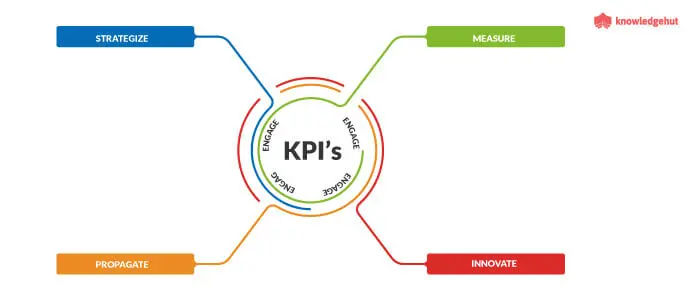
Myth 10: 0 Backlog Means Scrum was Success
Reality: If this was the case, then why did that product fail to make any money? Running through the complete list of to-do items and getting a sense of accomplishment is one thing, but it does not ensure success unless you made all along the way that you were doing the right thing. And that is measured by the concept of value and quality, and this is where Scrum Master and Product Owner play the most important roles.
Unleash your potential with our project management certification training. Boost your career and become a confident leader.
Difference Between Agile and Scrum
Agile and Scrum may seem like interchangeable terms, but there are distinct differences between the two project management practices. Both approaches are based on an iterative and incremental approach, but they have different characteristics and principles.
| Agile | Scrum |
| Agile is a development methodology that is best suited for small, expert project development teams. | Scrum is one of the vital implementations of agile methodology, in which incremental builds are directly delivered to the customer every two to three weeks. |
| In the Agile process, the leadership plays an indispensable role and there is not much room for frequent changes. | Scrum is ideally used in projects where the requirement is rapidly changing. |
| Agile involves collaborations as well as face-to-face interactions between the members of various cross-functional teams. | Scrum fosters a self-organizing, cross-functional team, with a fixed role assigned to the scrum master, product owner, and team members. |
| Agile can require lots of up-front development processes and organizational change. | The biggest advantage of Scrum is its innate flexibility, as it quickly reacts to changes. |
| The agile method needs repeated and frequent delivery to the end user for their feedback. | In Scrum, collaboration is achieved in daily stand-up meetings, and a build is delivered to the client after each sprint for their feedback. |
| Each step of development like requirements, analysis, and design, are continually monitored during the lifecycle. | There is no team leader, which means that the entire team pays heed to the issues or problems collectively. |
| The Agile method has a positive attitude towards feedback at the time of process from the end user, in order to make the end product more useful. | Daily sprint meetings are conducted to review and provide feedback to decide the future development of the project. |
| Deliver, improve, and update the software on a regular basis and design as well as execution should be kept minimal and simple. | Design and execution do not have to be basic, it be innovative and experimental. |
| The Agile method prioritizes satisfying the customer by providing constant and continuous delivery of necessary software. | Empirical Process Control is a the core philosophy of Scrum-based processes, and working software is not an elementary measure. |
| Working software is the most elementary measure of progress, and face-to-face communication is encouraged. | The Scrum team focuses on delivering maximum business value, from the beginning of the project and throughout. |
| Agile principles include welcoming changing requirements, even late in development, attention to technical excellence, and self-organizing teams. | Scrum principles include self-organization, collaboration, time-boxing, and iterative development. |
Conclusion
Agile and Scrum are undoubtedly the most widely adopted methodologies in software development today. However, there is a lot of confusion surrounding Agile and Scrum's true value concerning project management. Many of these misconceptions originate from misunderstandings about Agile and can have disastrous consequences for development teams if not managed properly. Hopefully, this blog has helped clear up some confusion surrounding these approaches. Go for the best Agile certifications and master the agile methodology.
Frequently Asked Questions (FAQs)
1. What is the biggest mistake as a Scrum Master?
2. What are the 3 rules of Scrum?
3. What is the problem with Scrum?
4. What are the top 3 Agile myths and misconceptions?
Get Free Consultation
By submitting, I accept the T&C and
Privacy Policy
Ready to lead with Scrum expertise?
